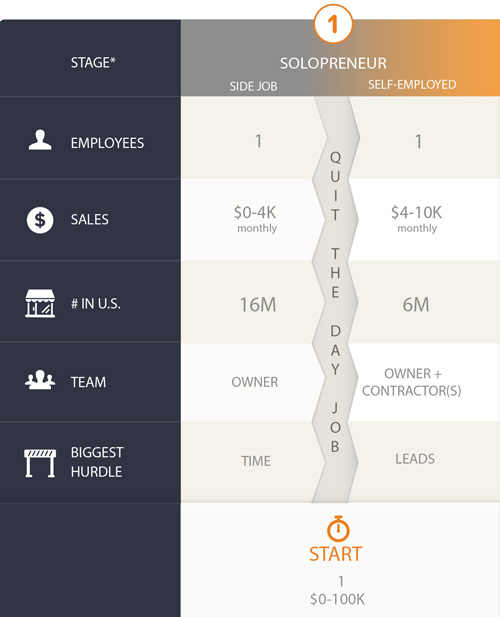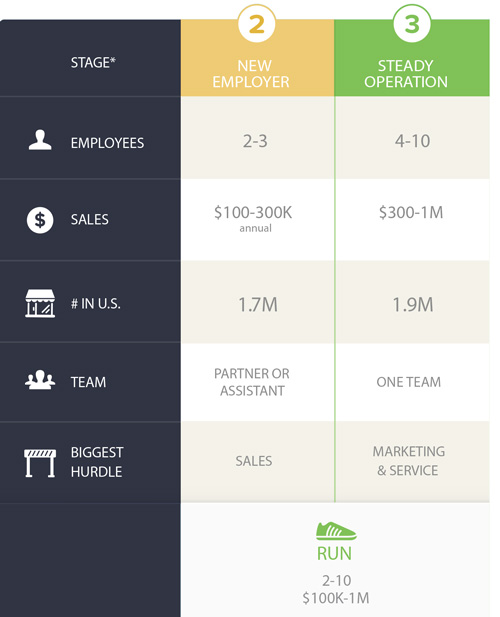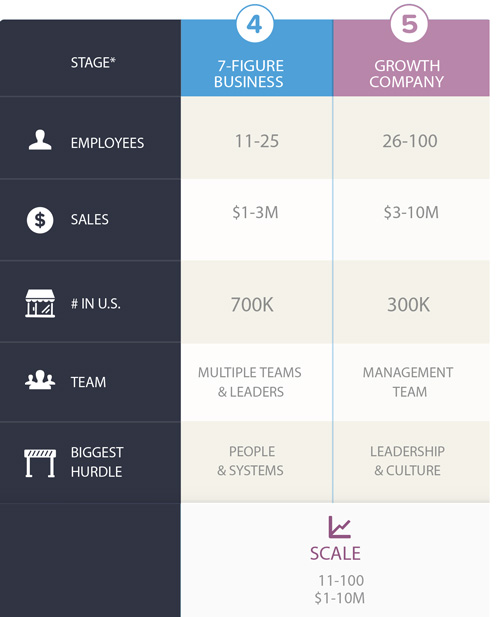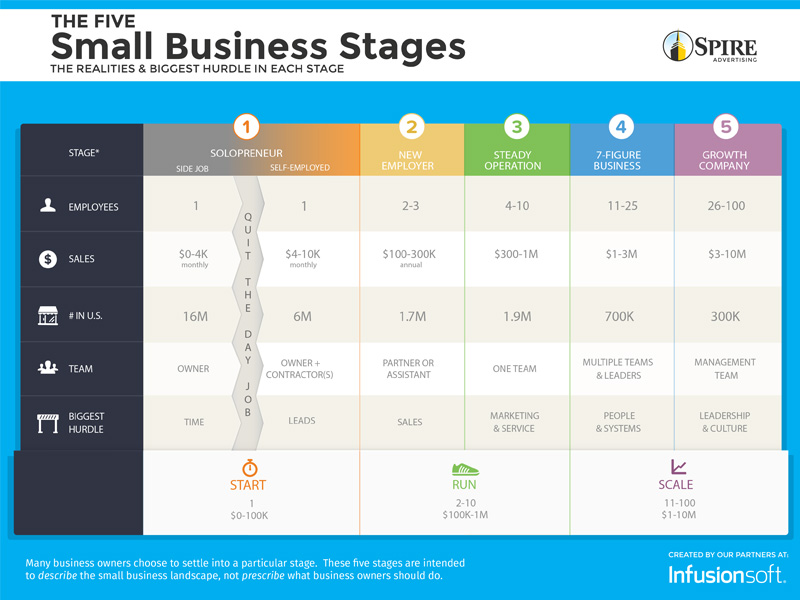Mastering 5 Stages of Small Business Growth
Author: Jeremy Harrison
Find Your Small Business Stage and Create a Plan to Grow
Growing a small business is a white-knuckle thrill ride. Not the roller coaster thrill ride where you’re strapped in with safety harnesses and practically everybody lives to tell about it… No, I’m talking about breakneck speeds on a motorcycle over a winding mountain road. You never know for sure what you’re going to see around the next bend.
Take your eyes off the road for a fraction of a second and you are…roadkill.
It’s no wonder we entrepreneurs get a little motion sickness after a while. Roller coasters only run a few minutes per ride for a reason – our systems aren’t built for constant adrenaline.
When starting my small business, I used to tell myself,
“When my business gets just a little bit bigger, everything is going to get easier.”
That sounds nice, but the truth is that each stage of small business has its own thrills as well as challenges. When you’re aware of what’s coming around the bend, you can make it safely out of the stage you’re in and be prepared for the next.
The Five Stages of Small Business Growth
Clate Mask, the CEO of Keap, created this chart many years ago:
Stage 1: Solopreneur
In Stage One, there are no other employees. It’s you against the world. You’ve started something, but it’s just getting off the ground. You may be working with a freelancer or a virtual assistant, but it’s basically a team of one.
The Numbers:
There are 22 million solopreneurs in the United States. Revenue is typically anywhere from zero to $100,000 per year.
The Biggest Challenge for Solopreneurs:
If you haven’t quit the day job, your biggest challenge is probably time as you balance the demands of the business with the rest of your life. Once you have quit the day job, your biggest challenge is getting leads to keep you working and paying the bills.
Pay Attention to Market Needs while Moving through Stage One
Solopreneurs are motivated to get to the next level because it’s a big deal when you can hire your first employee and off-load some of the work. But use this time in Stage One to make sure that you are filling a real need in the market. Anybody can get a few sales from friends who like you, but if the business isn’t filling a real need, you are in danger of getting stuck when you hit Stage Two.

Stage 2: New Employer
Stage Two can be an exciting time in a business. It’s when you start getting some help!
The Numbers:
There are 1.7 million Stage Two businesses in the United States. Revenue is typically anywhere from $100K to $300K per year, with 2-3 employees including the owner.
Biggest Challenge:
The biggest challenge for Stage Two businesses is often sales. As you get busy training a couple employees and making sure they are serving your customers well, it’s hard to keep bringing in new sales.
Stay Focused while Moving through Stage Two
When scrambling for new sales, a Stage Two leader sometimes loses their focus. “Our new employee Joe used to detail cars, maybe we can start offering that too.” This is a really bad idea. A jack-of-all-trades business will never have enough demand and sales. To increase demand, you actually need to TIGHTEN your focus to differentiate your business. It may sound counterintuitive, but it works.
Stage 3: Steady Operation
Stage Three is when your business starts hiring a few more people and running the business at a bigger level.
The Numbers:
Stage Three businesses have 4-10 employees and are typically running at $300K to $1M in sales. There are 1.9 million Stage Three businesses in the United States. Many find a spot they like at this stage and try to stay there.
Challenges:
The biggest challenges for Stage Three businesses are marketing and service, which go together. You need effective marketing to drive demand for your products and services. You also need to back it up with great customer service, which gets harder as you build your team.
Don’t Get too Comfortable in Stage Three
Stage Three is the last stage where a business owner can often lead their entire team without a management structure. So even if you choose to stay in Stage Three, don’t get too comfortable. A bicycle can’t coast up a hill for long before it starts rolling backward, so it’s important you have a great marketing strategy and keep differentiating your business from the competition.
One more thing. If freedom and flexibility were goals when you started your small business, don’t stay in Stage Three. You are leading everybody at this point, so it’s hard to build a business that’s bigger than you are at this level.

Stage 4: 7-Figure Business
Stage Four is when an entrepreneur breaks the elusive “million dollar barrier” and builds a 7-figure business that has the potential to really scale. But first, there are some new challenges to overcome.
The Numbers:
There are 700,000 Stage Four businesses in the United States. Revenue is typically anywhere from $1-3 million per year, with 11-25 employees.
Biggest Challenge
At Stage Four, people and systems become the biggest challenge. Teams are bigger and not everybody can report to the Owner/CEO anymore. The business is shifting into multiple teams led by more than one leader, and this can present new challenges for even the most talented and charismatic leaders.
Focus on Development, not Growth in Stage Four
In Stage Four, growth cannot be the goal. Focus on developing your people and developing systems they can use to serve your customers well. It is the responsibility of the CEO to develop the training and systems and to equip the other leaders to develop the rest of the team. By focusing on each person developing their skills and learning your system, growth will be a natural outcome.
Stage 5: Growth Company
At Stage Five, a business is reaching a new level of maturity and must be intentional to maintain the culture that made the company great.
The Numbers:
There are 300,000 Stage Five businesses in the United States. Revenue is typically anywhere from $3-10 million per year, with 25-100 employees.
Biggest Challenge:
At Stage Five, management and culture become the biggest challenge. Leaders are leading leaders, and the challenge for the founder is to keep the culture that came so naturally in earlier stages. At this point, employees can’t all know each other well, so instilling culture into the company is key.
Focus on “Why” in Stage Five
At Stage Five, the talent of a couple leaders won’t carry the company. Everyone must have clarity about WHY the company exists and their role in it. Leaders must focus on purpose, mission, and values to guide the company while finding ways to maintain the culture of the company.

Which Stage Is Your Small Business?
Where is your small business? Knowing where you’re at today can give you clarity about where you’re headed next. Growing a small business is a white-knuckle thrill ride. It’s not for everybody — most people prefer safer forms of transportation. But you are here for a reason and you will have epic stories to tell. You can do it.
Spire is uniquely positioned to help small businesses progress through the stages of small business growth. Find simplicity, direction, and a clearer vision for growth by taking part in a Marketing Plan Strategy Session for your business.

